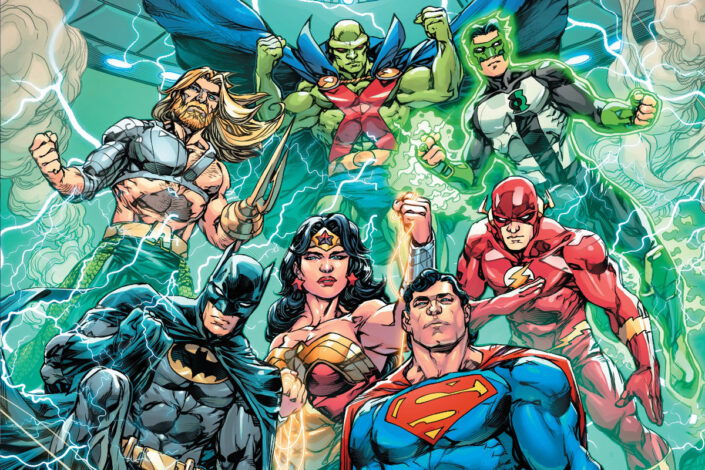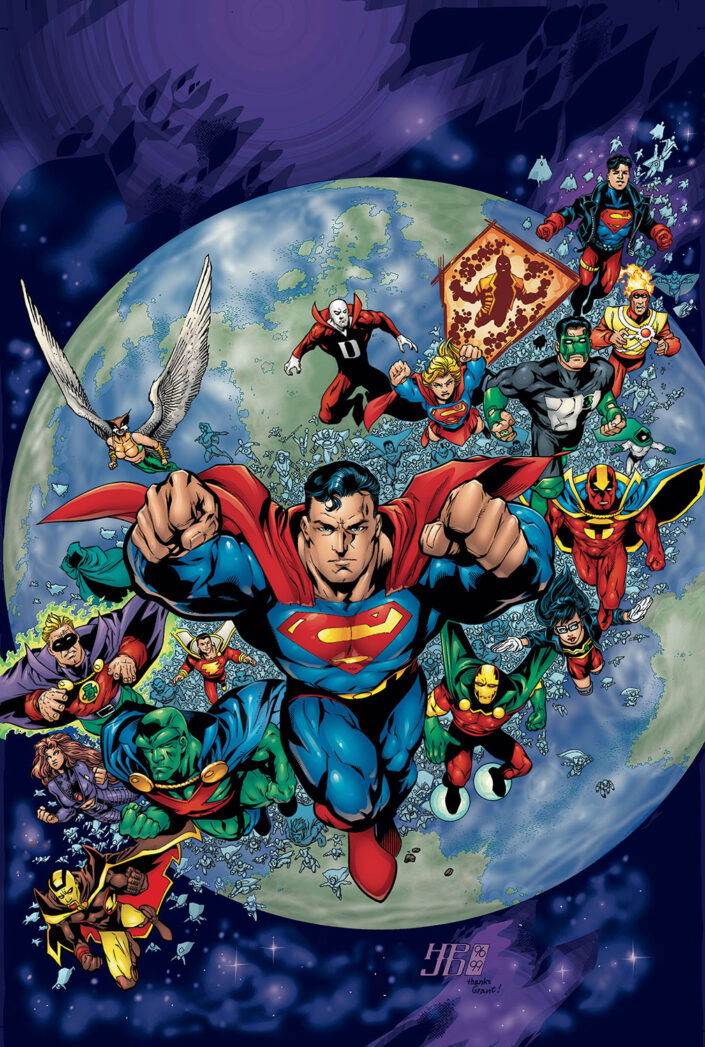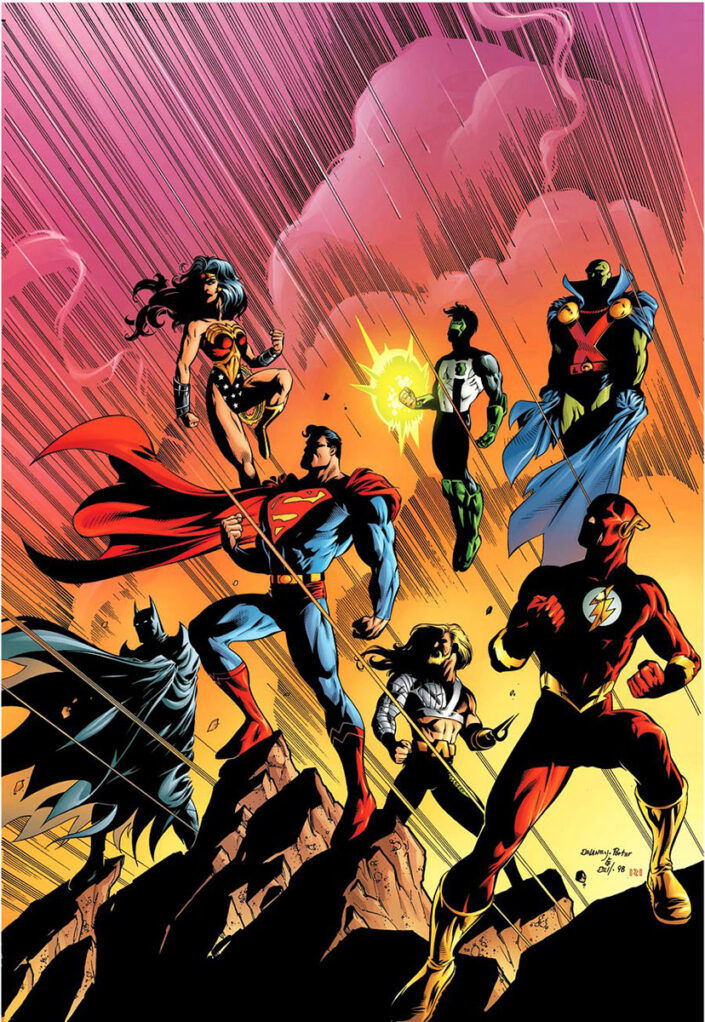
In 1986, Keith Giffen and J.M. DeMatteis launched Justice League International, a series that quickly became popular (see the reading order for details). By the mid-1990s, though, the success had faded, and the titles were canceled. DC Comics tried to revamp the League with Mark Waid and Fabian Nicieza’s miniseries Justice League: A Midsummer’s Nightmare. But it wasn’t until 1997, when Grant Morrison and artist Howard Porter launched the new JLA series, that the team found success again.
After years without A-listers, Grant Morrison brought the core team back together—Superman, Batman, Wonder Woman, and the rest—and introduced the idea of JLA as a modern pantheon of gods. To match this larger-than-life vision, the League moved into a new headquarters on the Moon, the Watchtower, and faced villains who threatened the world—or the entire universe. The creative team revisited and rebranded classic threats such as the White Martians, The Injustice Gang, and the Key, while also introducing new foes like Prometheus and Mageddon. Simply put, “JLA has rallied to save humankind from the brink of extinction. These are the adventures that have made them living legends.”
Grant Morrison’s run on JLA lasted four years, from 1997 to 2001. He wrote the series for the first 41 issues, along with a brief crossover during JLA’s “World War III” arc. During that time, the Justice League became one of DC’s best-selling titles and completely redefined the team for decades to come. It’s one of the most important runs in JLA history, and now you can explore it with our reading order!
![]()
JLA Core Members
Grant Morrison’s JLA brought back the classic “Big 7” of DC’s Justice League while adding less traditional characters to face the greatest threats, all while mirroring the Greek gods. Here’s the lineup along with their Olympian counterparts (credits to Avenging-X-Bolt):
- Superman — Zeus, King of the gods and the sky.
- Batman — Hades, king of the underworld, god of the dead and wealth.
- Wonder Woman — Hera, Queen of the Gods and Goddess of Women.
- Aquaman — Poseidon, King of the sea
- The Flash (Wally West) — Hermes, God of Speed.
- Green Lantern (Kyle Rayner) — Apollong, God of light and art.
- The Martian Manhunter — Chiron, a Centaur not a god, but a mentor to the Gods.
- Oracle — Athena, Goddess of wisdom, warfare, and handicraft.
- Zauriel — Eros, God of love and sex
- Plastic Man — Dionysus, God of wine, revelry, and chaos.
- Orion — Ares, God of war
- Steel — Hephaestus, God of fire and metalworking.
- Huntress — Artemis, the goddess of the hunt
- Barda — Hestia, Goddess of the hearth and the home

Your Complete Guide to Reading Grant Morrison’s JLA Collected Editions
Grant Morrison and Howard Porter’s run on JLA has been reprinted in several collections. Below is your guide to help you choose the best editions for you:
The New JLA Trade Paperback Collection
DC Comics has begun reprinting the complete run of Grant Morrison and Howard Porter’s JLA, including all related mini-series and one-shots, in a new ongoing trade paperback collection.
- JLA Book One
Collects JLA #1-9, JLA Secret Files & Origins#1, JLA/WILDC.A.T.S #1, and the never-before-collected JLA: Tomorrow Woman #1, JLA 80-Page Giant #1, JLA Annual #1, JLA: Paradise Lost #1-3, and JLA Gallery. - JLA Book Two [2025]
Collects JLA #10-23; JLA Annual #2; JLA Secret Files and Origins #2; New Year’s Evil Prometheus #1; JLA: World Without Grown-Ups #1-2. - More Coming Soon…
JLA Omnibus
The entire run collected in one big book in hardcover format.
- JLA by Grant Morrison Omnibus
Collects JLA #1-17, #22-26, #28-31, #34, #36-#41, JLA One Million, and JLA: Earth 2.
JLA Deluxe Editions
JLA is also available in Deluxe Editions, offered in both hardcover and softcover formats.
- JLA: The Deluxe Edition, Vol. 1
Collects JLA #1-9, JLA Secret Files #1. - JLA: The Deluxe Edition, Vol. 2
Collects JLA #10-17, New Year’s Evil: Prometheus, JLA/Wildcats. - JLA: The Deluxe Edition, Vol. 3
Collects JLA #22-26, 28-31, #1,000,000. - JLA: The Deluxe Edition, Vol. 4
Collects JLA #34, #36-41, JLA: Classified #1-3, JLA Earth 2.
JLA original trades Paperback
JLA was first reprinted in in a series of trade paperbacks.
- JLA, Vol. 1: New World Order
Collects JLA #1–4. - JLA, Vol. 2: American Dreams
Collects JLA #5–9.- JLA #1-9 are also collected in JLA: New World Order (DC Essential Edition).
- JLA, Vol. 3: Rock of Ages
Collects JLA #10–15. - JLA, Vol. 4: Strength in Numbers
Collects JLA #16–23, JLA Secret Files and Origins #2, New Year’s Evil: Prometheus (one-shot). - JLA, Vol. 5: Justice for All
Collects JLA #24–33. - JLA, Vol. 6: World War III
Collects JLA #34–41. - JLA Earth 2

Grant Morrison’s JLA Comics Reading Order: Issue by Issue
Even if Grant Morrison’s JLA run can be read alone, the characters continued to evolve in their own ongoing comic series. Changes affected the Justice League and here is what you need to know:
- JLA #1–4 “New World Order”
- Superman Blue Vol. 1: Superman loses his traditional powers and transforms into a being of electromagnetic energy.
- JLA #5 “Woman of Tomorrow”
- JLA #6–7 “Fire in the Sky”
- JLA #8–9 “Imaginary Stories”
- JLA Secret Files & Origins #1 “Star-Seed”
- JLA/WildC.A.T.s (one-shot) – a DC/Image crossover event with art by Val Semeiks.
- Wonder Woman (vol. 2) #125 “Deathwatch” collected in Wonder Woman by John Byrne Vol. 3 – The members of the JLA come to say goodbye to one of their own as Wonder Woman got her soul incinerated by Neron. For more, take a look at our Wonder Woman Reading Order.
- Aztek the Ultimate Man – Short series from Grant Morrison and Mark Millar introducing Aztek, aka Uno who was raised from childhood by a secret organization named the Q Society to be the champion of the Aztec god Quetzalcoatl to battle their enemy, the Aztec god Tezcatlipoca. Aztek joined the Justice League in Aztek, The Ultimate Man #10.
- JLA #10–15 “Rock of Ages”
- Prometheus (one-shot)
- JLA #16–17 “Prometheus Unbound”
- The short Superman Blue era concluded in Superman Vol 2 #135.
- JLA #22–23 “Conquerors”
- For a short period of time, Hippolyta was Wonder Woman. Diana is back at the end of Wonder Woman Vol 2 #136 taking place at the end of the JLA #23 main story but before the epilogue. Collected in Wonder Woman by John Byrne Vol. 3.
- JLA One Million (one-shot)
- DC One Million: The event (see reading order here) takes place after JLA #23, as the final two pages of this issue lead into the story.
- JLA #24–26 “Executive Action”
- JLA #28–31 “Crisis Times Five”
- JLA #34 “The Ant and the Avalanche”
- JLA #36–41 “World War III”
Grant Morrison’s run officially ended here, but he wrote two more JLA Stories after that.
- JLA: Earth 2 (graphic novel)
- JLA Classified #1–3: “Ultramarine Corps”
![]()
After Grant Morrison’s JLA
Once Grant Morrison left the title, Mark Waid took over and wrote one of the most famous JLA storylines, The Tower of Babel. With Joe Kelly, Waid stayed on the series until #90, then switched to a series of rotating writers until its cancellation with #126.
- JLA: The Tower of Babel
Collects JLA #18-21, #32-33, and #43-46, and two stories from JLA Secret Files #3.
To continue your adventure with DC Comics’ greatest team, explore our Complete Justice League Reading Guide.
Hi guys, love your reading orders.
Any chance of a Wildstorm reading order (or essencial reading order since i know is not all good) since the Authority movie is coming?
Hi Matheus,
Thanks for your comment.
We have an article about The Authority planned, but no big Wildstrom reading order for the moment. Also, an essential/best reading order, to begin with, is quite a good idea.
We take notes, and we’re going to see what we can do on that subject!